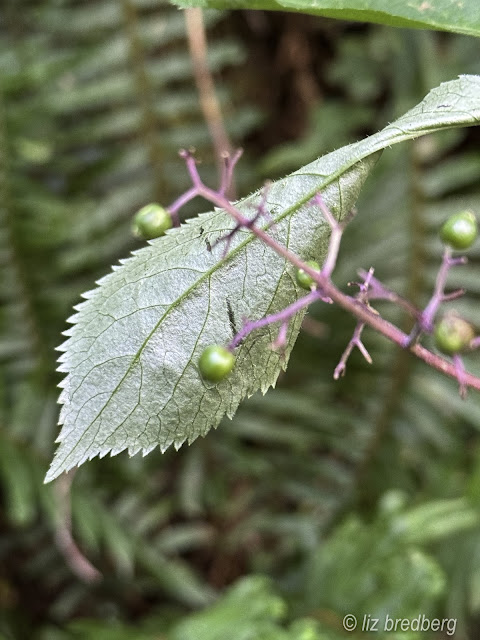23 June
As the poem says, "What is so rare as a day in June?" The east coast of Vancouver Island doesn't seem to have read the next line about "perfect days."* Our most recent visit to the Wetlands and Forest was fine, rich in new flowers and emerging fruit, but still chilly and cloudy.
Nevertheless, as ever, the path welcomed us.
We're seeing an increase in the growth of cascara--partly this is our ability to recognise the tree,
but in part it's plainly due to new plants establishing themselves.
Its proliferation may be due to developments in modern pharmacology. In the early years of the twentieth century, cascara was in demand as a laxative, not least to remedy the diet of stodge fed the military in the two world wars. Harvesting cascara bark was a popular source of income for people on Vancouver Island, where the tree grew. Unfortunately, this resulted in fewer trees throughout the forests. But now, apart from adherents of folk medicine, it has ceased to be a popular remedy and the trees seem to be regenerating. It's an interesting case of the relationship of human digestion, pharmacology, and forestry.
The bird population seemed quieter this morning. We heard ravens, Pacific wrens, and blackbirds, song sparrows, and yellowthroats and red-winged blackbirds at the marsh. Birds weren't visible, though. There was, however, a very big and robust banana slug on the path.
The foam flower is flourishing. (Say rapidly six times...)
Actual blossoms on bedstraw seem uncommon. These tiny examples are among the first I've seen, despite the abundance of the plant.
Elder flowers have become elderberries, but birds have found them before they ripen.
A nurse stump is nurturing a tiny pair of buttercups.
Then, if ever, come perfect days;
Then Heaven tries the earth if it be in tune,
And over it softly her warm ear lays:
Whether we look, or whether we listen,
We hear life murmur, or see it glisten;
Every clod feels a stir of might,
An instinct within it that reaches and towers,
And, groping blindly above it for light,
Climbs to a soul in grass and flowers;
The flush of life may well be seen
Thrilling back over hills and valleys;
The cowslip startles in meadows green,
The buttercup catches the sun in its chalice,
And there's never a leaf nor a blade too mean
To be some happy creature's palace;--from James Russell Lowell, The Vision of Sir Launfal


















Comments
Post a Comment